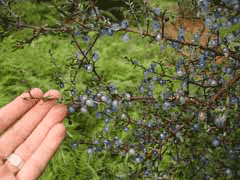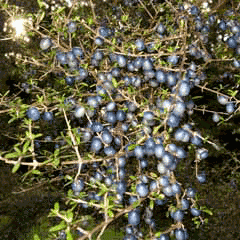 |
|
http://flickr.com/photos/16921893%40N00/ |
 |
| http://flickr.com/photos/16921893%40N00/137374702 |
Translate this page:
Summary
Physical Characteristics

 Coprosma propinqua is an evergreen Shrub growing to 6 m (19ft 8in).
Coprosma propinqua is an evergreen Shrub growing to 6 m (19ft 8in).
See above for USDA hardiness. It is hardy to UK zone 7. It is in leaf all year, in flower from February to March, and the seeds ripen from August to September. The species is dioecious (individual flowers are either male or female, but only one sex is to be found on any one plant so both male and female plants must be grown if seed is required). and is pollinated by Wind. The plant is not self-fertile.
Suitable for: light (sandy) and medium (loamy) soils and prefers well-drained soil. Suitable pH: mildly acid and neutral soils. It can grow in semi-shade (light woodland) or no shade. It prefers moist soil.
UK Hardiness Map
US Hardiness Map
Synonyms
Plant Habitats
Woodland Garden Sunny Edge; Dappled Shade; Hedge;
Edible Uses
Edible Parts: Fruit
Edible Uses: Coffee
Fruit - raw or cooked[173]. Sweet, but with little flavour[225]. The pale to deep violet-blue fruit is about 8mm wide[200, 225]. The roasted seed is an excellent coffee substitute[153].
References More on Edible Uses
Medicinal Uses
Plants For A Future can not take any responsibility for any adverse effects from the use of plants. Always seek advice from a professional before using a plant medicinally.
None known
References More on Medicinal Uses
The Bookshop: Edible Plant Books
Our Latest books on Perennial Plants For Food Forests and Permaculture Gardens in paperback or digital formats.

Edible Tropical Plants
Food Forest Plants for Hotter Conditions: 250+ Plants For Tropical Food Forests & Permaculture Gardens.
More

Edible Temperate Plants
Plants for Your Food Forest: 500 Plants for Temperate Food Forests & Permaculture Gardens.
More

More Books
PFAF have eight books available in paperback and digital formats. Browse the shop for more information.
Shop Now
Other Uses
Dye Hedge Hedge
Tolerant of pruning, it makes a good dense hedging plant[225]. A yellow dye is obtained from the wood, it does not require a mordant[153].
Special Uses
Hedge Hedge
References More on Other Uses
Cultivation details
Requires a moist, very well-drained neutral to slightly acid soil in full sun or light shade[200]. An easily grown plant, it succeeds in most soils[225]. Somewhat intolerant of frost, this species is only likely to succeed outdoors in the milder areas of Britain[11, 200]. Another report says that it is fully hardy in Britain[225]. It flowers freely in Britain, fruiting heavily if pollinated[225]. A polymorphic species, it hybridizes freely with other members of this genus[200, 225]. Plants are tolerant of heavy clipping or pruning[225]. Plants are normally dioecious, though in some species the plants produce a few flowers of the opposite sex before the main flowering and a few hermaphrodite flowers are sometimes produced[225]. Male and female plants must usually be grown if seed is required.
References Carbon Farming Information and Carbon Sequestration Information
Temperature Converter
Type a value in the Celsius field to convert the value to Fahrenheit:
Fahrenheit:
The PFAF Bookshop
Plants For A Future have a number of books available in paperback and digital form. Book titles include Edible Plants, Edible Perennials, Edible Trees,Edible Shrubs, Woodland Gardening, and Temperate Food Forest Plants. Our new book is Food Forest Plants For Hotter Conditions (Tropical and Sub-Tropical).
Shop Now
Plant Propagation
Seed - probably best sown as soon as it is ripe in a greenhouse or cold frame[K]. Sow stored seed in spring in a cold frame[200]. Germination can be slow, often taking more than 12 months even when fresh seed is used[K]. When the seedlings are large enough to handle, prick them out into individual pots. Grow on the plants for at least their first winter in a greenhouse and plant out in late spring or early summer. Give the plants some protection from the cold for their first winter outdoors[K]. Cuttings of mature wood of the current year's growth, autumn in a frame.
Other Names
If available other names are mentioned here
Native Range
AUSTRALASIA: New Zealand (Chatham Islands Territory, North Island, South Island, Stewart Island)
Weed Potential
Right plant wrong place. We are currently updating this section.
Please note that a plant may be invasive in one area but may not in your area so it's worth checking.
Conservation Status
IUCN Red List of Threatened Plants Status :

Growth: S = slow M = medium F = fast. Soil: L = light (sandy) M = medium H = heavy (clay). pH: A = acid N = neutral B = basic (alkaline). Shade: F = full shade S = semi-shade N = no shade. Moisture: D = dry M = Moist We = wet Wa = water.
Now available:
Food Forest Plants for Mediterranean Conditions
350+ Perennial Plants For Mediterranean and Drier Food Forests and Permaculture Gardens.
[Paperback and eBook]
This is the third in Plants For A Future's series of plant guides for food forests tailored to
specific climate zones. Following volumes on temperate and tropical ecosystems, this book focuses
on species suited to Mediterranean conditions—regions with hot, dry summers and cool, wet winters,
often facing the added challenge of climate change.
Read More
Expert comment
Author
Cunn.
Botanical References
1144200
Links / References
For a list of references used on this page please go here
Readers comment